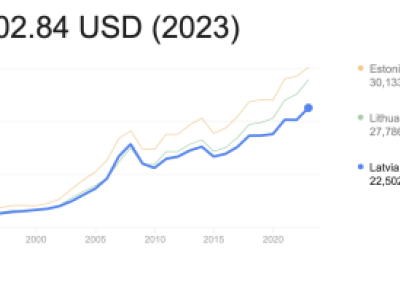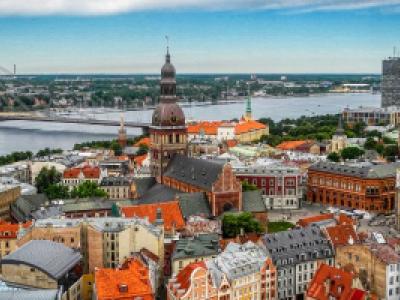A while ago, I compared the GDP of Baltic nations with Caucasian nations using data from 2012. As we are now in the second half of 2014, it's time to revisit this comparison using the most recent data available from the World Bank for 2013.
Some might argue, "Why compare these regions?" Well, why not?
Baltic States and South Caucasus GDP (2012-2013)
Country | 2012 ($bln) | 2013 ($bln) | Growth ($bln) |
|---|---|---|---|
Azerbaijan | 68.73 | 73.56 | 4.83 |
Lithuania | 42.34 | 43.82 | 1.48 |
Latvia | 28.37 | 29.61 | 1.24 |
Estonia | 22.37 | 24.47 | 2.10 |
Georgia | 15.84 | 16.12 | 0.28 |
Armenia | 9.95 | 10.43 | 0.48 |
Total | 187.6 | 198.01 | 10.41 |
The largest economy among these six former Soviet Union countries in 2013 was Azerbaijan, with a GDP of $73.56 billion. The smallest economy was Armenia, with a GDP of $10.43 billion. Given the ongoing military conflict over Nagorno-Karabakh, Armenia faces significant economic challenges. Armenia's economy is approximately seven times smaller than Azerbaijan's.
Following Azerbaijan are the Baltic states: Lithuania, Latvia, and Estonia. Georgia has a slightly larger economy than Armenia.
Overall, these two political and economic regions had a combined GDP of just under $200 billion in 2013. Previously, I wondered which region would first reach the $100 billion mark.
South Caucasus GDP Breakdown (2012-2013)
Country | 2012 ($bln) | 2013 ($bln) | Growth ($bln) | % of Total |
|---|---|---|---|---|
Azerbaijan | 68.73 | 73.56 | 4.84 | 73.4% |
Georgia | 15.84 | 16.12 | 0.28 | 16.1% |
Armenia | 9.95 | 10.43 | 0.48 | 10.4% |
Total | 94.62 | 100.11 | 5.6 | 100% |
The South Caucasus region reached the $100 billion mark in 2013, with Azerbaijan contributing the lion's share at 73.4%.
Baltic States GDP Breakdown (2012-2013)
Country | 2012 ($bln) | 2013 ($bln) | Growth ($bln) | % of Total |
|---|---|---|---|---|
Lithuania | 42.34 | 43.82 | 1.48 | 44.75% |
Latvia | 28.37 | 29.61 | 1.24 | 30.24% |
Estonia | 22.37 | 24.47 | 2.10 | 24.99% |
Total | 93.08 | 97.90 | 4.82 | 100% |
In the Baltic region, Lithuania leads with 44.75% of the GDP, followed by Latvia and Estonia. The Baltic economies appear more balanced compared to the South Caucasus, largely due to the absence of significant natural resources and a more diversified economic structure.
GDP Per Capita Comparison (2013)
Country | 2012 ($) | 2013 ($) | Growth ($) | % Growth |
|---|---|---|---|---|
Estonia | 16,887 | 18,478 | 1,591 | 9.42% |
Lithuania | 14,172 | 14,688 | 516 | 3.64% |
Latvia | 13,947 | 14,588 | 641 | 4.59% |
Azerbaijan | 7,394 | 7,812 | 418 | 5.65% |
Georgia | 3,529 | 3,602 | 73 | 2.07% |
Armenia | 3,354 | 3,505 | 151 | 4.50% |
The Baltic states lead in GDP per capita, with Estonia at the top with $18,478 in 2013. Armenia, at $3,505, lags significantly behind. Lithuania and Latvia follow Estonia, though with a noticeable gap. Azerbaijan, driven by its oil and gas economy, reached $7,812 per capita, outpacing Georgia and Armenia by about twice as much.
Minimum Wages Comparison (2014)
Country | 2013 ($) | 2014 ($) | Growth ($) | % Growth |
|---|---|---|---|---|
Estonia | 427 | 480 | 53 | 12.41% |
Latvia | 379 | 432 | 53 | 13.98% |
Lithuania | 385 | 391 | 6 | 1.56% |
Azerbaijan | 133 | 133 | 0 | 0% |
Armenia | 108 | 110 | 2 | 1.85% |
Georgia | 54 | 51 | -3 | -5.56% |
Minimum wages also reveal stark differences. The Baltic states have considerably higher minimum wages than the South Caucasus countries, with Estonia leading at $480 per month in 2014. Azerbaijan and Armenia have much lower minimum wages, and Georgia saw a decrease.
Conclusion
Since the collapse of the Soviet Union, the Baltic and Caucasus regions have taken different paths. The Baltic states have integrated into the European Union and achieved more balanced and diversified economies. In contrast, the South Caucasus faces ongoing conflicts and economic disparities.
While Azerbaijan's oil and gas resources have bolstered its GDP, the region's stability remains fragile due to the Nagorno-Karabakh conflict. As Georgia seeks closer ties with the European Union, the economic and political landscape of these regions continues to evolve.


